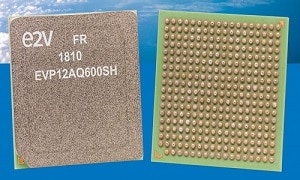The device can withstand a high total ionising dose (TID) and meets stringent requirements of NASA and ESA

For addressing the challenging space application scenarios, here’s presenting a four-channel analogue-to-digital converter (ADC) that is qualified for space deployments.
Through the supply of mixed-signal technology that delivers exceptional degrees of reliability, the EV12AQ600 by Teledyne e2v has demonstrated to withstand a total ionising dose (TID) of 150kRad. Hence, the TID and SEE results prove that this device is a perfect fit for space applications like long-term missions or GEO satellites.
With respect to the test procedure, the ADC had to endure multi-axis mechanical shock and vibration tests, plus electro-static discharge (ESD), extreme temperature and thermal cycling. Having successfully passed all of the tests mentioned, it now meets NASA and ESA requirements, complying with the stringent MIL-PRF-38535 (QML-Y) and ESCC 9000 standards. As such, the EV12AQ600 series devices have already been employed in numerous mission-critical military and avionics applications. Its space qualification will open up many new opportunities for their usage.
This 12-bit ADC supports 1.6GSps data sampling rates on each of their channels, or 6.4GSps across a single channel when interleaved. They are not known to exhibit the poor interface stability that is witnessed on devices from other ADC manufacturers when placed into a space environment. Consequently, customers can have full confidence in their long-term operation once deployed.
The ADC has certain other attributes that benefit space applications. Thanks to the cross-point switch situated after the inputs, this device is much more versatile than other solutions. The ADC can easily be reconfigured remotely, once it has been incorporated into the orbit. The number of channels, the bit rate and the dynamic range can all be altered via the accompanying FPGA, allowing new functional requirements to be achieved.
Such inherent flexibility also facilitates design reuse to suit different application criteria. Therefore, fewer engineering resources are required to accelerate the development time. A comprehensive collection of FPGA libraries are available to further assist with project development work, leveraging Teledyne e2v’s inclusion in the Xilinx ecosystem (XQRKU060) for space implementations.
“Through our space-qualified EV12AQ600 devices, we can offer customers high-performance data converter solutions that are ready to integrate directly into their systems,” explains Nicolas Chantier, Marketing Director at Teledyne e2v. “It means that they can benefit from flight-proven TRL9 technology, without the need for any further qualification effort.” “Also, with inventory now available, there are much shorter lead times associated with these ADCs than competing solutions currently on the market. Customers can therefore get access to samples straight away,” he adds.






